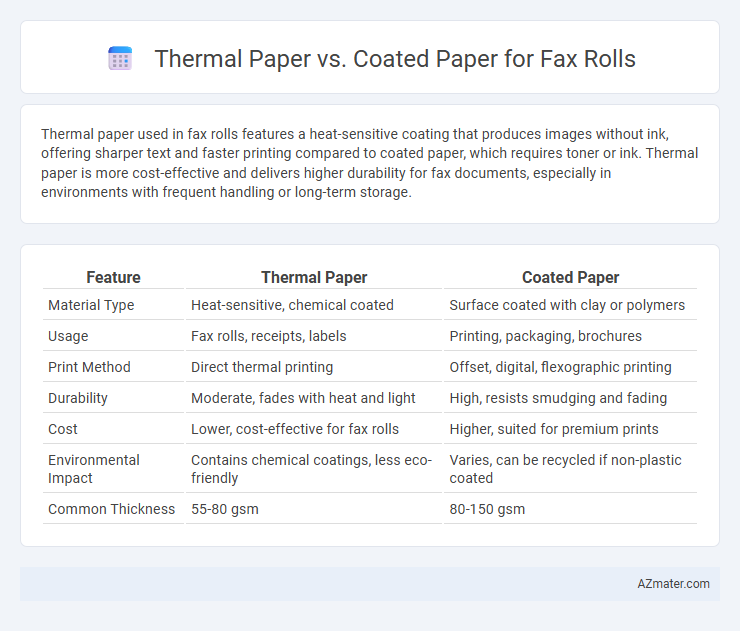Thermal paper used in fax rolls features a heat-sensitive coating that produces images without ink, offering sharper text and faster printing compared to coated paper, which requires toner or ink. Thermal paper is more cost-effective and delivers higher durability for fax documents, especially in environments with frequent handling or long-term storage.
Table of Comparison
| Feature | Thermal Paper | Coated Paper |
|---|---|---|
| Material Type | Heat-sensitive, chemical coated | Surface coated with clay or polymers |
| Usage | Fax rolls, receipts, labels | Printing, packaging, brochures |
| Print Method | Direct thermal printing | Offset, digital, flexographic printing |
| Durability | Moderate, fades with heat and light | High, resists smudging and fading |
| Cost | Lower, cost-effective for fax rolls | Higher, suited for premium prints |
| Environmental Impact | Contains chemical coatings, less eco-friendly | Varies, can be recycled if non-plastic coated |
| Common Thickness | 55-80 gsm | 80-150 gsm |
Introduction to Fax Roll Paper Types
Thermal paper for fax rolls features a heat-sensitive coating that darkens when exposed to thermal print heads, enabling fast and quiet printing without ink. Coated paper for fax rolls, on the other hand, is treated with a smooth layer of clay or polymer to improve ink absorption and print clarity, making it suitable for traditional ink-based fax machines. Choosing between thermal and coated fax roll paper depends on the specific fax machine technology and the desired print quality and durability.
What is Thermal Paper?
Thermal paper is a specialized heat-sensitive paper commonly used in fax rolls, designed to produce images without ink by reacting to thermal printheads. This paper consists of a base layer coated with a chemical that darkens when exposed to heat, enabling clear, sharp printouts ideal for fax machines and receipt printers. Compared to coated paper, thermal paper offers faster, quieter printing and requires no ribbons or toner, making it a cost-effective choice for high-volume fax applications.
What is Coated Paper?
Coated paper for fax rolls features a smooth surface treated with a layer of clay or polymer to enhance print quality, durability, and brightness compared to uncoated options. Unlike thermal paper, which relies on heat-sensitive chemicals to produce images without ink, coated paper requires toner or ink for printing, making it less suitable for heat-based fax machines. The coating improves resistance to smudging and fading, providing sharper text and images ideal for long-term document preservation.
Key Differences Between Thermal and Coated Paper
Thermal paper for fax rolls features a heat-sensitive coating that darkens when exposed to the printer's thermal head, eliminating the need for ink or toner. Coated paper, on the other hand, has a layer of pigment or polymer that improves print quality and durability but requires traditional ink-based printing methods. The key differences include printing technology compatibility, durability, and cost efficiency, with thermal paper being ideal for quick, low-cost fax printing and coated paper suited for high-quality, long-lasting prints.
Print Quality Comparison
Thermal paper delivers superior print quality for fax rolls by producing crisp, sharp text and clear images without the need for ink, leveraging heat-sensitive coating technology. Coated paper, while offering a smooth surface, often requires toner or ink, which can result in smudging and less precise print resolution. The thermal paper's ability to maintain consistent print definition under various environmental conditions makes it the preferred choice for high-quality fax roll outputs.
Durability and Longevity
Thermal paper for fax rolls features a heat-sensitive coating that enables fast, quiet printing without ink but is prone to fading and discoloration over time when exposed to heat or light, reducing durability. Coated paper, typically treated with a protective layer, offers enhanced resistance to moisture, abrasion, and UV exposure, resulting in longer-lasting prints ideal for archival purposes. Choosing coated paper ensures extended longevity and better preservation of fax documents compared to the more fragile thermal paper.
Compatibility with Fax Machines
Thermal paper is specifically designed for thermal fax machines, utilizing heat-sensitive coating that reacts to the machine's thermal print heads, ensuring clear and precise image reproduction without the need for ink. Coated paper, while having a smooth surface and enhanced durability, is typically incompatible with thermal fax machines as it lacks the heat-sensitive layer required for printing. Using thermal paper in fax rolls guarantees optimal compatibility and print quality, minimizing paper jams and machine malfunctions compared to coated paper variants.
Cost Analysis: Thermal vs Coated Paper
Thermal paper for fax rolls generally presents a lower initial cost due to its simpler manufacturing process and absence of ink requirement, making it cost-effective for high-volume printing. In contrast, coated paper involves higher material and processing expenses driven by additional coatings and ink usage, resulting in increased overall costs. Long-term cost analysis favors thermal paper as it reduces maintenance and operational expenses linked to ink replacement and printer wear.
Environmental Impact and Disposal
Thermal paper used in fax rolls contains chemical coatings like BPA or BPS that pose environmental hazards and complicate recycling, often resulting in landfill waste. Coated paper rolls, while treated for print quality, typically use less harmful substances and are more compatible with conventional recycling processes. Proper disposal methods for thermal paper require specialized recycling or chemical treatment to minimize environmental contamination.
Choosing the Right Fax Roll Paper
Choosing the right fax roll paper is crucial for optimal fax machine performance, with thermal paper and coated paper offering distinct benefits. Thermal paper provides clear, sharp images through heat-sensitive coating, ideal for quick, high-quality fax outputs without ink, while coated paper enhances durability and moisture resistance, making it suitable for archival fax documents. Considering print quality, longevity, and environmental conditions helps determine the best fax roll paper, ensuring reliability and cost-efficiency in fax communications.

Infographic: Thermal paper vs Coated paper for Fax roll
 azmater.com
azmater.com